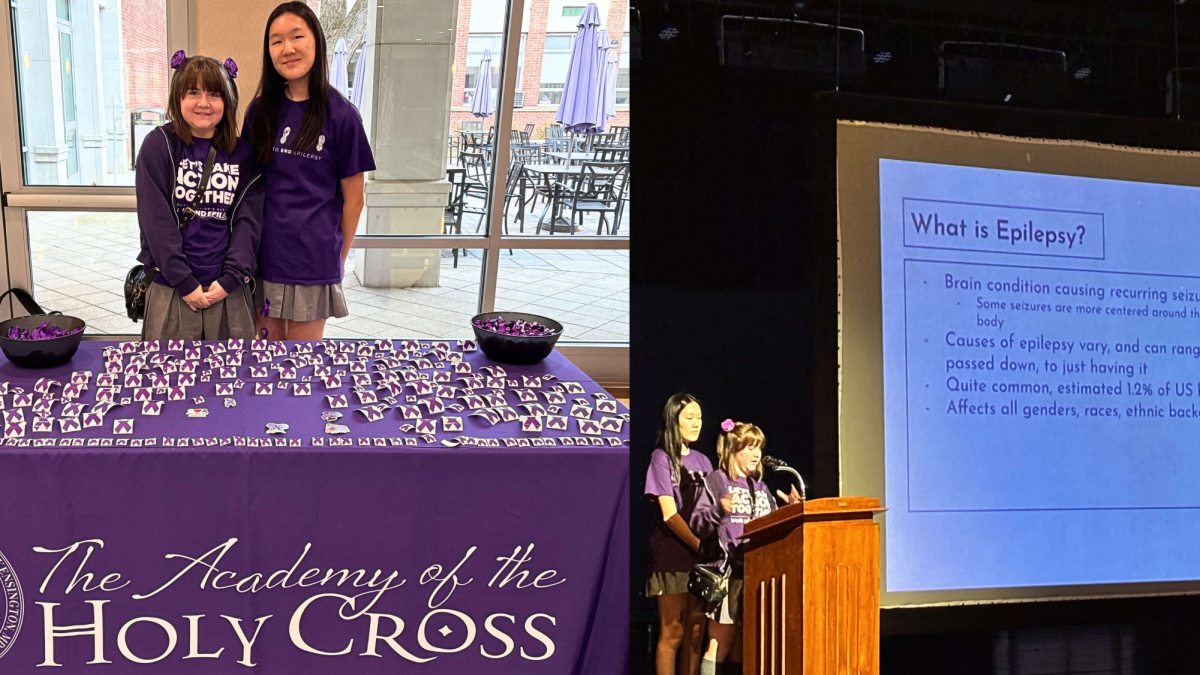The student body gathered in the theater on Monday, November 18 for a presentation on epilepsy, a neurological disorder which causes recurring seizures. In honor of Epilepsy Awareness Month, junior Maddie Hilton and sophomore Lia Jung shared a presentation on behalf of the Health and Wellness Board, intending to educate students and teachers alike about epilepsy.
The presentation aimed to spread awareness, share vital information, and combat harmful misconceptions about epilepsy. It refuted the misconception that epilepsy is uncommon, sharing the statistic that 1 in 26 people live with epilepsy—which amounts to approximately 3.4 million people affected nationwide, and about 65 million globally. “When you look at our school, you see 2 out of 400, making it seem more uncommon, but in reality it’s not,” Jung explained. The presentation also noted that epilepsy can be developed at any point in life and can affect anyone, regardless of race, age, or gender.
Hilton and Jung also outlined some specifics of epilepsy, including different types of seizures, symptoms, triggers, and treatments. The student speakers explained that seizures are separated into two categories, focal onset and generalized onset seizures. The two categories differ in that focal onset seizures begin in one area on one side of the brain, whereas generalized seizures take place on both sides of the brain at once. Between the two categories, over 40 different types of seizures have been discovered.
The presentation also included information about the impact epilepsy can have on a person’s life. Both Hilton and Jung shared their own personal experiences, connecting with their audience on a deeper level and attesting to the information they previously shared. In disclosing their own stories, the two shed light on how epilepsy manifests differently in each individual. “Epileptics experience epilepsy in different ways,” Hilton explained. “For example, [our] experiences differ greatly between our symptoms, triggers, and even life effects.”
By raising awareness, these student leaders helped promote understanding of a commonly misunderstood illness and took measures that are part of a greater mission to end harmful stigmas surrounding epilepsy and to create safer, more compassionate environments for epileptics. “I think it’s important that people are given the opportunity to learn about other people’s experiences, especially when it comes to things that most people might never really know for themselves,” Hilton shared.
Kathryn Dundee, a junior who attended the presentation, shared what she took away from the assembly. “I didn’t realize how common epilepsy is. It feels more tangible now, knowing that so many people around me are affected by it.” Dundee also shared that most of the information in the presentation was brand new to her. “I didn’t know how much seizures can vary from person to person. Learning what different seizures can look like is what stood out to me most.”
With this presentation, Hilton and Jung each made an impact on their school community, bringing an issue close to their hearts to the attention of their peers. As Jung put it, “Epilepsy awareness is showing and normalizing the understanding of the disorder.” Jung also touched on why such awareness is important. “Epilepsy, in my opinion, falls onto a borderline between known and unknown. Because of this, it’s really important that there are people out there who want to spread knowledge about epilepsy, such as Maddie and I.”
Following the assembly, students received purple epilepsy awareness ribbons and stickers as a way to show their support and to raise awareness for this important cause. Now students walk the halls with purple ribbons pinned to their skirts in support of their classmates and others around them affected by epilepsy.
“I’ve been wearing the ribbon to show my support for people affected by epilepsy. It’s a simple way to raise awareness, which is especially important when misconceptions surrounding a disorder can be so harmful,” Dundee remarked.



